Discussion thread for Dypsis madagascariensis. If you would like to add a comment, click the Post Reply button.
You are using an out of date browser. It may not display this or other websites correctly.
You should upgrade or use an alternative browser.
You should upgrade or use an alternative browser.
Dypsis madagascariensis
- Thread starter brodklop
- Start date
Jeff Searle
Well-Known Member
- 2,354
- 26/08/08
- 79
- 88
A nice palm for our area. I have several now that are producing mega amounts of seeds, but because of the economy, I haven't been saving them.
Most when grown from seed will send suckers off the main plant, but some remain single, which I think creates a real nice looking specimen.
Jeff
Most when grown from seed will send suckers off the main plant, but some remain single, which I think creates a real nice looking specimen.
Jeff
- 9,565
- 28/09/07
- 121
- 223
Yes,
Apparently this is one of those Dypsis that has a lot of variablity - like D. baronii. Many of the different forms acquire their own name, adding to considerable confusion - but also adding to the fun.
Apparently this is one of those Dypsis that has a lot of variablity - like D. baronii. Many of the different forms acquire their own name, adding to considerable confusion - but also adding to the fun.
I thought I'd throw my lot in here with a few questions and statements of my experience with growing these.
Firstly let me say sometimes I think the term " variable species" sometimes is a botanical code for " I don't have the time or resources to spend much time on this species at this time".
The problem is there are to few botanists specializing in this vast area of palms.
JD himself said in the context of Pigafetta that he only gave a casual glace at this species as there were to many other palm to look at in Asia to be concerned with this.
It wasn't until some growers in Queensland confronted him with the 2 different forms that a description for the 2 species was made.
It goes to show the pressure botanists are under.
I take my hat of to them.
Somehow I think the D. madagacariensis complex is in this category, as with other Dypsis like "slick willy" v onilahensis.
One has to ask the question what constitutes variability. Is it a matter of different forms coming from the same batch of seed. Like the 2 colours of Areca vestiaria. These can be both single and multi trunked as is Areca triandra.
On the question of variability can a palm develop a heal on one form and not on the other and still be classified as the same species. This is the big question regarding "slick Willy" and onilahensis.
With this in question I have some photos that show D. madagascariensis/ mahajanga and another similar form having a heal and D. madagascariensis/ diego form and D. madagascariensis/ lucebensis not having a heal.
So the question is can the same species be healed and non healed.
D. madagascariensis/ mahajang showing a heal
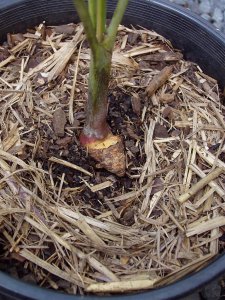
Similar form Called Dypsis sp blue showing heal and spliting
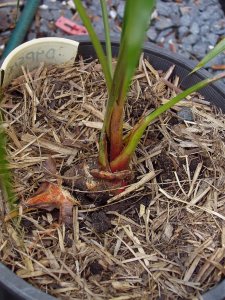
D. madagascariensis/ diego form with no heal
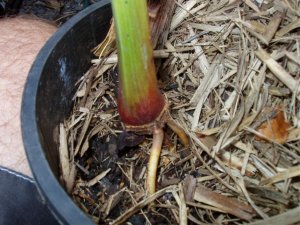
D. madagascariensis/ lucebensis with no heal
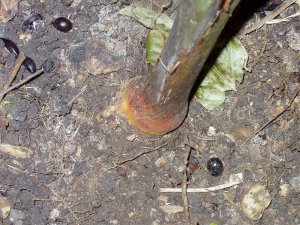
Has anyone grown from seed a heal forming palm from the lucebensis form and also had it other than single trunk. In my 30 years of palm growing I have grown lucebensis and it has never had a heal or sucker.
I have grown the diego, mahajanga and others and they have all been consistant within the seed batches. Because I collected the seed myself I know the source trees.
I know this is a boring old plant but its good to get a better look at it.
A question for Jeff, are the trees you have growing the large single Lucebensis form with the large espanded base, or are they the multiple stem type. As you said they can produce single and multiple stems. This is true of most inherently muti stem palms.
Firstly let me say sometimes I think the term " variable species" sometimes is a botanical code for " I don't have the time or resources to spend much time on this species at this time".
The problem is there are to few botanists specializing in this vast area of palms.
JD himself said in the context of Pigafetta that he only gave a casual glace at this species as there were to many other palm to look at in Asia to be concerned with this.
It wasn't until some growers in Queensland confronted him with the 2 different forms that a description for the 2 species was made.
It goes to show the pressure botanists are under.
I take my hat of to them.
Somehow I think the D. madagacariensis complex is in this category, as with other Dypsis like "slick willy" v onilahensis.
One has to ask the question what constitutes variability. Is it a matter of different forms coming from the same batch of seed. Like the 2 colours of Areca vestiaria. These can be both single and multi trunked as is Areca triandra.
On the question of variability can a palm develop a heal on one form and not on the other and still be classified as the same species. This is the big question regarding "slick Willy" and onilahensis.
With this in question I have some photos that show D. madagascariensis/ mahajanga and another similar form having a heal and D. madagascariensis/ diego form and D. madagascariensis/ lucebensis not having a heal.
So the question is can the same species be healed and non healed.
D. madagascariensis/ mahajang showing a heal

Similar form Called Dypsis sp blue showing heal and spliting

D. madagascariensis/ diego form with no heal

D. madagascariensis/ lucebensis with no heal

Has anyone grown from seed a heal forming palm from the lucebensis form and also had it other than single trunk. In my 30 years of palm growing I have grown lucebensis and it has never had a heal or sucker.
I have grown the diego, mahajanga and others and they have all been consistant within the seed batches. Because I collected the seed myself I know the source trees.
I know this is a boring old plant but its good to get a better look at it.
A question for Jeff, are the trees you have growing the large single Lucebensis form with the large espanded base, or are they the multiple stem type. As you said they can produce single and multiple stems. This is true of most inherently muti stem palms.
Here are some of the seed source trees
The diego form which isn't forming a heal ( for me any rate ). Thin stiff leaflets and whitish trunks
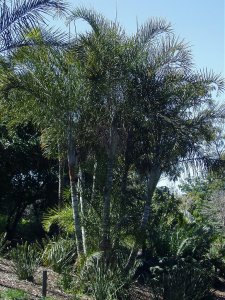
Mahajanga form which form a heal on all plants I have grown so far. Green thick trunks with droopy tipped thinish leaflets
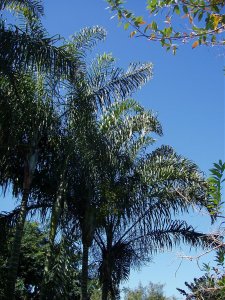
I particularly like this form. Anyone growing this. Green thinner trunks with thick droopy tipped leaflets

Again
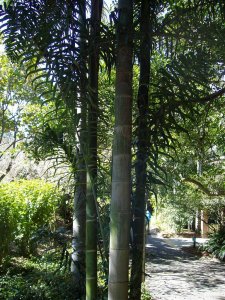
The diego form which isn't forming a heal ( for me any rate ). Thin stiff leaflets and whitish trunks

Mahajanga form which form a heal on all plants I have grown so far. Green thick trunks with droopy tipped thinish leaflets

I particularly like this form. Anyone growing this. Green thinner trunks with thick droopy tipped leaflets

Again

palmnerd
Well-Known Member
- 1,323
- 05/12/08
- 0
- 56
Some cultural notes on the mentioned forms of dypsis from central Fl.. The plant sold to me as Dypsis madagascariensis about ten years ago, by Rick Kern from Palm Beach county, goes through a severe decline during the winter months. It's not cold damage in as much as it is blighted by some mold or fungus. I've used copper, daconil neem and mycostop to try to curb this decline with some success. The majajanga form on the other hand does not decline at all during the cooler months. I was at a palm meeting this past weekend, one of the host properties had three large D. madagascariensis, all exhibiting the same pattern declination and summer time recovery growth. The dypsis madagascariensis is the yellow looking palm photo under heavy mango canopy. I inclueded comparative shots of the mahajanga to show the difference in health between the two forms. I included a shot of the mahajanga trunk if that helps you any brodklop.




